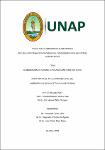| dc.contributor.advisor | Tello Célis, Fernando | |
| dc.contributor.advisor | Arévalo Del Águila, Segundo | |
| dc.contributor.advisor | Rios Mera, Juan Dario | |
| dc.contributor.author | Santos Jara, Claudia Milena | |
| dc.contributor.author | Piña Vásquez, Julio Armin | |
| dc.date.accessioned | 2019-02-25T14:18:22Z | |
| dc.date.available | 2019-02-25T14:18:22Z | |
| dc.date.issued | 2019 | |
| dc.identifier.uri | http://repositorio.unapiquitos.edu.pe/handle/20.500.12737/5866 | |
| dc.description.abstract | El excesivo consumo de sodio trae efectos negativos como hipertensión y problemas cardiovasculares, razón por la que la industria alimentaria considera su sustitución por sales alternativas en la formulación parcial de diferentes productos procesados. En este estudio se evaluó el efecto de la sustitución parcial del contenido de NaCl por KCl en cecina de cerdo, mediante los niveles de sodio, análisis microbiológicos, sensoriales y vida útil a través de la estabilidad oxidativa de lípidos (TBARS); así mismo se determinó las características fisicoquímicas. De acuerdo con nuestro diseño experimental Diseño Compuesto Central Rotacional (DCCR), se realizaron 12 primeros ensayos a las cuales se determinó el análisis de oxidación, tomando en cuenta el menor valor para la selección de los 4 mejores resultados (sustitución de NaCl de 0%, 25%, 42.7% y 50%), que fueron empacados al vacío y almacenados a 8ºC por 30 días. La cecina fue elaborada a partir del lomo de cerdo, ensalmuerada por 6 horas a 4ºC en concentraciones de 3.0%, 3.6%, 5.0%, 6.4% y 7%, teniendo como estequiometria carne/salmuera (1:2), y ahumadas a 80ºC durante 150 minutos.
Se observó el incremento de proteínas cuando se obtuvo valores más bajos de humedad, teniendo así 30.42%, 33.61%, 40.13% y 40,15% para valores de humedad de 58.19%, 55.24%, 47.87% y 45.56% respectivamente. En cuanto a la evaluación microbiológica, se encontró dentro de los límites establecidos de la norma de salud peruana, y a través de la evaluación sensorial los consumidores no detectaron diferencias cuando se sustituyó al 25% con CS 5% siendo bien valorados, muy diferente cuando se sustituyó al 42.7% y 50% a CS de 6.4% 5% haciéndolo más aceptable a la primera; además no presentaron enranciamiento encontrándose por debajo de los rangos recomendados para productos cárnicos; sugiriendo así que es posible sustituir NaCl en un 25% en cecina mediante el uso de KCl. Esta reducción permitió una disminución en los niveles de sodio del 15.17% en el producto final. | es_PE |
| dc.description.abstract | Currently the excessive consumption of sodium has negative effects such as hypertension and cardiovascular problems, which is why the food industry is taking into account its substitution by other alternative salts in the partial formulation of elaboration of different processed products considering potassium chloride as the best substituent for having characteristics similar to sodium chloride, without neglecting the maintenance of physical, chemical, sensory and microbiological parameters. To reduce this problem, the objective of this work was to replace the NaCl content with KCl in pork jerky, evaluate the centesimal and microbiological composition and the sensory characteristics. Likewise, the useful life was determined by the oxidative stability of the lipids through the thiobarbituric acid test (TBARS). According to our Experimental Design Rotational Central Compound Design (DCCR), 12 first tests were performed to which the oxidation analysis was determined, from which only the 4 best results were selected (substitution of 25% NaCl, 42.7% and 50%). %), having as reference the lowest peroxide index during storage in vacuum packaging at 8ºC for 30 days. The jerky was prepared from the pork loin, blended in concentrations of 3.0%, 3.6%, 5.0%, 6.4% and 7%, having as stoichiometry meat / brine (1: 2), and smoked at 80ºC during 150 minutes. The increase in proteins was observed when lower moisture values were obtained, thus taking 30.42%, 33.61%, 40.13% and 40.15% for moisture values of 58.19%, 55.24%, 47.87% and 45.56% respectively. Regarding the microbiological evaluation, it was found within the established limits of the Peruvian health norm, and through the sensory evaluation the consumers did not detect differences when 25% was substituted with CS 5% being well valued, very different when it was replaced to 42.7% and 50% to CS of 6.4% 5% making it more acceptable to the former; in addition they did not show rancidity being below the ranges recommended for meat products; suggesting that it is possible to substitute 25% NaCl in cecina through the use of KCl. This reduction allowed a decrease in sodium levels of 15.17% in the final product. | en_EN |
| dc.description.uri | Tesis | es_PE |
| dc.format | application/pdf | es_PE |
| dc.language.iso | spa | es_PE |
| dc.publisher | Universidad Nacional de la Amazonía Peruana | es_PE |
| dc.rights | info:eu-repo/semantics/openAccess | es_PE |
| dc.rights | Attribution-NonCommercial-NoDerivs 3.0 United States | * |
| dc.rights.uri | http://creativecommons.org/licenses/by-nc-nd/3.0/us/ | * |
| dc.source | Universidad Nacional de la Amazonía Peruana | es_PE |
| dc.source | Repositorio institucional - UNAP | es_PE |
| dc.subject | Elaboración de alimentos | es_PE |
| dc.subject | Carne de cerdo | es_PE |
| dc.subject | Sodio | es_PE |
| dc.title | Elaboración de cecina con bajo contenido de sodio | es_PE |
| dc.type | info:eu-repo/semantics/bachelorThesis | es_PE |
| thesis.degree.discipline | Ingeniería en Industrias Alimentarias | es_PE |
| thesis.degree.grantor | Universidad Nacional de la Amazonía Peruana. Facultad de Industrias Alimentarias | es_PE |
| thesis.degree.level | Título Profesional | es_PE |
| thesis.degree.name | Ingeniero en Industrias Alimentarias | es_PE |
| thesis.degree.program | Regular | es_PE |
| dc.subject.ocde | Alimentos y bebidas | es_PE |
| dc.subject.ocde | http://purl.org/pe-repo/ocde/ford#2.11.01 | es_PE |


